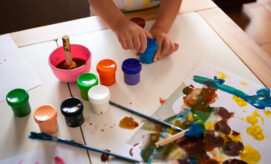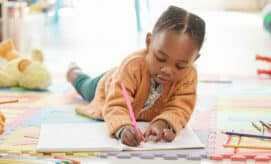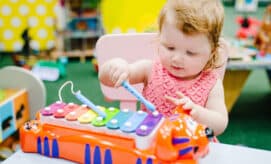Each day, children are growing, getting stronger, and developing new skills. During the first five years of life, children learn to roll over, crawl, stand, walk, hop, and more! They love to discover all the ways that their bodies can move and interact with the world around them. Many children particularly enjoy moving along with music. Incorporating music and movement into the early childhood classroom helps children to learn important life skills, and invites children to use movement as a tool for exploration, communication and expression.
Movement as a Tool for Learning
Because movement is such a natural part of children’s exploration, using movement in an early childhood classroom is a great way to support children’s learning and self-expression. April Kaiser, an educator at the Child Development and Family Center at Northern Illinois University explains, “Most children are quite at home with movement. They begin to learn about the world by acting on objects and people, and they ‘think with their bodies’ well before they think with words. This is why body movement is not only fun for children but also a good opportunity for them to solve problems.”
Movement also provides an opportunity for children to try out social skills that can help them build relationships and form friendships. In her article for NAEYC’s Young Child Magazine, author Connie Bergstein Dow explains that through movement, “children learn that they each can contribute to the group and that they can all work together to find a solution. Listening and responding to directions, offering suggestions, exploring others’ ideas while waiting for a turn, and simply moving in a shared space together are opportunities for learning and practicing social skills.”
Deborah J. Stewart, M.Ed., an educator for over 30 years and author of the blog teachpreschool.org, gives an example of how music can be used in an ECE classroom as a tool for learning. She shares one of her favorite songs to sing with young children: “The seed begins in the garden, / Tiny and small. / But then it grows, and grows, and grows, / Big and Tall!” This song can be sung with children as they explore plants that are growing in your yard or in your classroom. You might also sing this song with children after reading a book about plants. As children sing the song, they can move with the words by starting in a crouched position, and then grow…grow…grow big and tall as they stand up and stretch their arms towards the ceiling.
Music and movement can be particularly powerful learning tools when incorporated into your classroom’s daily routine and curriculum. Because they tap into the type of active learning that many children enjoy, singing, dancing, and moving can help children to better learn and integrate the foundational academic skills that will set them up for success in kindergarten. An NAEYC article shares:
“integrating the performance arts—music, drama, and dance—into core subjects helps young children learn better across the curriculum. Arts-integrated teaching taps into children’s natural desire for active learning through the senses. By singing, dancing, imagining, and connecting their bodies and minds, children learn more deeply and meaningfully, especially in subjects like reading, math, and science…A recent study confirmed that arts-integrated instruction techniques can boost learning in subjects other than the arts. Arts-integrated learning is not an extra or an add-on for early learning educators, but a valuable strategy to prepare young children for success in school.”
Ideas for Movement & Music Classroom Learning Activities
Music is an incredibly versatile tool that can be used in an early learning environment in a variety of different ways. In the article listed above for NAEYC’s Young Child magazine, Connie Bergstein Dow shares the following ideas…
-
During an exploration of shapes, children can use their bodies to form circles, squares, triangles, or other shapes; walk or march making floor patterns such as figure eights, straight lines, and zigzag lines; or jump and make shapes in the air, like an X or Y.
-
When children are fidgety, try integrating movement into a learning game, like a counting game: ‘Let’s count to five while we fidget. Now let’s count to seven’ or a game of opposites: ‘Fidget as much as you can. and when I clap my hands, freeze!’… Fidgeting can become a vocabulary game: ‘What is another word for fidget? Squirm! Jiggle! Wiggle!’ Intersperse movement games like these throughout the children’s day for rich learning opportunities.
-
Offer movement tasks and problems for children to solve individually and as a group: ‘How many ways can you move from sitting to standing?’ ‘How many ways can you make a big curve like the letter C with your body?’ ‘Imagine we are back in the days of the dinosaurs. What would we see? Can you move like a pterodactyl?’
An article from HighScope shares additional ideas for incorporating music into different parts of the day with young children…
-
Clean-up time: Ask children to clean up while music is playing and to freeze when the music stops. Count how many times it takes to clean and stop before the children have finished.
-
Small group time: Have children paint while listening to fast and slow songs and compare how they may paint differently depending on the music. Ask children to think about how the music makes them feel and have them draw how they feel or think.
-
Free time: Encourage children to create a series of movements to a particular song on their own.
Resources for Further Exploration





